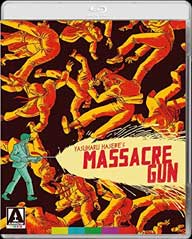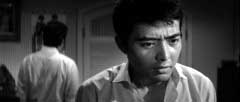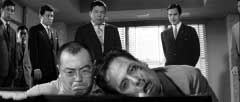 MASSACRE
GUN (1967) Blu-ray/DVD combo
MASSACRE
GUN (1967) Blu-ray/DVD comboDirector: Yasuharu Hasebe
Arrow Video USA
 MASSACRE
GUN (1967) Blu-ray/DVD combo
MASSACRE
GUN (1967) Blu-ray/DVD comboNikkatsu Studios hits Blu-ray on American shores courtesy of Arrow Video USA's combo release of the Jô Shishido vehicle MASSACRE GUN.

When Boss Akazawa (Takashi Kanda, INVASION OF THE NEPTUNE MEN) orders the death of his mistress, hitman Kuroda (Jô Shishido, A COLT IS MY PASSPORT) does so without question despite the fact that she was in love with him. Disgusted, Kuroda's younger brother Saburo (Jirô Okazaki, RETALIATION) breaks ties with Akazawa who has been sponsoring his boxing career. When Akazawa's men break Saburo's hands in response, Kuroda quits working for him and remains quietly defiant in the face of his former boss' intimidation tactics until his former friend Shirasaka (Hideaki Nitani, TIDAL WAVE) issues a final warning. Realizing that they have to strike first, Kuroda and his hot-headed middle brother Eiji (Tatsuya Fuji, BLACK SUN) begin taking over the businesses that pay Akazawa protection money as well as a cut of his illegal gambling sessions. While Shirasaka is conflicted about fighting his best friend, another of Akazawa's ambitious thugs Konno grabs one of Kuroda's allies and sends him back in a coffin. When they kidnap Saburo, Kuroda goes to Akazawa with the purpose of offering up himself in his brother's place, but they are rescued by Eiji who impulsively shoots Akazawa during their getaway. While Eiji is ready to take over the rest of the city, Kuroda is not in such a celebratory mood since removing Akazawa puts him in direct conflict with Shirasaka with no chance of either backing down.
 Modeled
on American gangster films, MASSACRE GUN never surprises its plotting or stylistic
audaciousness along the lines of fellow Nikkatsu auteur Seijun Suzuki (YOUTH
OF THE BEAST) or even Hasebe's first film BLACK TIGHT KILLERS and his later
Roman Porno ASSAULT! JACK THE RIPPER; yet its noir-ish photography and icy jazz
– including musical interjections of Ken Sanders (TOKYO DRIFTER) who functions
as sort of a jazzy Greek chorus – are so hypnotically cool. There are
only four female characters in the film – Azakawa's first mistress, his
replacement mistress who Eiji beds, Saburo's innocent love interest Aiko (Yôko
Yamamoto, DUEL IN THE STORM), and Shirasaka's wife Shino (Tamaki Sawa, BLACK
RAIN) who implores Kuroda to make peace with her husband – with the film's
conflict played out on the alternately brooding and agonized faces of its male
characters, particularly Sishido's anti-hero who still bows his head or looks
away from Akazawa and Shiraska even after breaking away from them. Hesebe would
stay with Nikkatsu through its Roman Porno phase (helming titles like RAPE:
THE 13TH HOUR and RAPING) but would leave in the eighties for Kadokawa Pictures,
the former Daiei Film which had been a merger of Nikkatsu and a few other studios
as part of the Japanese government's efforts to rationalize film production
during the war.
Modeled
on American gangster films, MASSACRE GUN never surprises its plotting or stylistic
audaciousness along the lines of fellow Nikkatsu auteur Seijun Suzuki (YOUTH
OF THE BEAST) or even Hasebe's first film BLACK TIGHT KILLERS and his later
Roman Porno ASSAULT! JACK THE RIPPER; yet its noir-ish photography and icy jazz
– including musical interjections of Ken Sanders (TOKYO DRIFTER) who functions
as sort of a jazzy Greek chorus – are so hypnotically cool. There are
only four female characters in the film – Azakawa's first mistress, his
replacement mistress who Eiji beds, Saburo's innocent love interest Aiko (Yôko
Yamamoto, DUEL IN THE STORM), and Shirasaka's wife Shino (Tamaki Sawa, BLACK
RAIN) who implores Kuroda to make peace with her husband – with the film's
conflict played out on the alternately brooding and agonized faces of its male
characters, particularly Sishido's anti-hero who still bows his head or looks
away from Akazawa and Shiraska even after breaking away from them. Hesebe would
stay with Nikkatsu through its Roman Porno phase (helming titles like RAPE:
THE 13TH HOUR and RAPING) but would leave in the eighties for Kadokawa Pictures,
the former Daiei Film which had been a merger of Nikkatsu and a few other studios
as part of the Japanese government's efforts to rationalize film production
during the war.

Largely unreleased outside of Japan, MASSACRE GUN makes its stateside debut on Blu-ray/DVD combo courtesy of Arrow Video's dual US/UK all region release. The 1080p24 MPEG-4 AVC 2.35:1 widescreen release looks exquisite in its monochromatic contrasts but for the visible splice lines at several shot changes. Definition is a tad soft overall, but this is a result of the Nikkatsu Scope anamorphic lenses (as is the slight distortion at the edges of the frame in wide angle shots). The Japanese LPCM 1.0 mono track is incredibly clean and full-bodied, handling the icy jazz as smoothly as the stabbing voices and canned gunplay sound effects. The optional English subtitles cover the dialogue as well as the song lyrics.
 Extras
start off with an interview with eighty-year-old star Shishido (17:37) speaking
in a combination of Japanese and English that is ably translated and transcribed
by optional subtitles. He discusses his upper middle class childhood in which
he was fascinated with sword play and then moved on to pistols (which had less
to do with the war than the normal things that fascinate kids at that age),
as well as his love for American B-movies and the actors who inspired him. Of
MASSACRE GUN, he mentions that there were no stunt coordinators or fight choreographers,
and that he coordinated the action himself as he had on other films (and admits
that he probably would not be able to tell the difference between one film or
another without the title). While he still has his pistol and demonstrates his
quick draw (he was also a fan of American westerns), a lot of his souvenirs
from the films were lost in a fire three years before.
Extras
start off with an interview with eighty-year-old star Shishido (17:37) speaking
in a combination of Japanese and English that is ably translated and transcribed
by optional subtitles. He discusses his upper middle class childhood in which
he was fascinated with sword play and then moved on to pistols (which had less
to do with the war than the normal things that fascinate kids at that age),
as well as his love for American B-movies and the actors who inspired him. Of
MASSACRE GUN, he mentions that there were no stunt coordinators or fight choreographers,
and that he coordinated the action himself as he had on other films (and admits
that he probably would not be able to tell the difference between one film or
another without the title). While he still has his pistol and demonstrates his
quick draw (he was also a fan of American westerns), a lot of his souvenirs
from the films were lost in a fire three years before.
 What
is described as an interview with film historian Tony Rayns (36:26) is actually
a ten chapter discussion of the history of Nikkatsu films from its beginnings
during the silent era and concentration on period samurai films and modern melodrama
that followed Kabuki conventions including the use of men in women's roles (both
the intention to use women in female roles and the transition to sound were
both met with protest by different unions early on), early standout directors
like Sadao Yamanaka (SAZEN TANGE AND THE POT WORTH A MILLION RYO) and Kenji
Mizoguchi (who directed Nikkatsu's first sound film HOMETOWN), and the production
slowdown during the war (after which they had a backlog of Hollywood acquisitions
to exploit through their own theater chain). In 1954, Nikkatsu launched a "New
Face" competition in search of new star talent (including Sishido) as well
as pursuing behind the scenes talent from rival studio Shochiko such as Suzuki,
Yuzo Kawashima (SUN IN THE LAST DAYS OF THE SHOGUNATE), and Shohei Imamura (THE
INSECT WOMAN). Rayns also discusses Nikkatsu's practices of double billing features
that would usually play for only a week before swapping out both features or
the A- or B-feature meant an output of over one hundred features per year requiring
low budgets and fast schedules, as well as how television, bankruptcy, and lawsuits
hurt the company in its later years before it decided to focus exclusively on
Roman Porno. Also included are the film's theatrical trailer (2:25), a promotional
gallery, reversible cover, and booklet by Japanese film expert Jasper Sharp
who provided commentary on Arrow's release of BLIND WOMAN'S CURSE (the latter
two not included for review). The DVD side of the package is Region 0 NTSC.
(Eric
Cotenas)
What
is described as an interview with film historian Tony Rayns (36:26) is actually
a ten chapter discussion of the history of Nikkatsu films from its beginnings
during the silent era and concentration on period samurai films and modern melodrama
that followed Kabuki conventions including the use of men in women's roles (both
the intention to use women in female roles and the transition to sound were
both met with protest by different unions early on), early standout directors
like Sadao Yamanaka (SAZEN TANGE AND THE POT WORTH A MILLION RYO) and Kenji
Mizoguchi (who directed Nikkatsu's first sound film HOMETOWN), and the production
slowdown during the war (after which they had a backlog of Hollywood acquisitions
to exploit through their own theater chain). In 1954, Nikkatsu launched a "New
Face" competition in search of new star talent (including Sishido) as well
as pursuing behind the scenes talent from rival studio Shochiko such as Suzuki,
Yuzo Kawashima (SUN IN THE LAST DAYS OF THE SHOGUNATE), and Shohei Imamura (THE
INSECT WOMAN). Rayns also discusses Nikkatsu's practices of double billing features
that would usually play for only a week before swapping out both features or
the A- or B-feature meant an output of over one hundred features per year requiring
low budgets and fast schedules, as well as how television, bankruptcy, and lawsuits
hurt the company in its later years before it decided to focus exclusively on
Roman Porno. Also included are the film's theatrical trailer (2:25), a promotional
gallery, reversible cover, and booklet by Japanese film expert Jasper Sharp
who provided commentary on Arrow's release of BLIND WOMAN'S CURSE (the latter
two not included for review). The DVD side of the package is Region 0 NTSC.
(Eric
Cotenas)